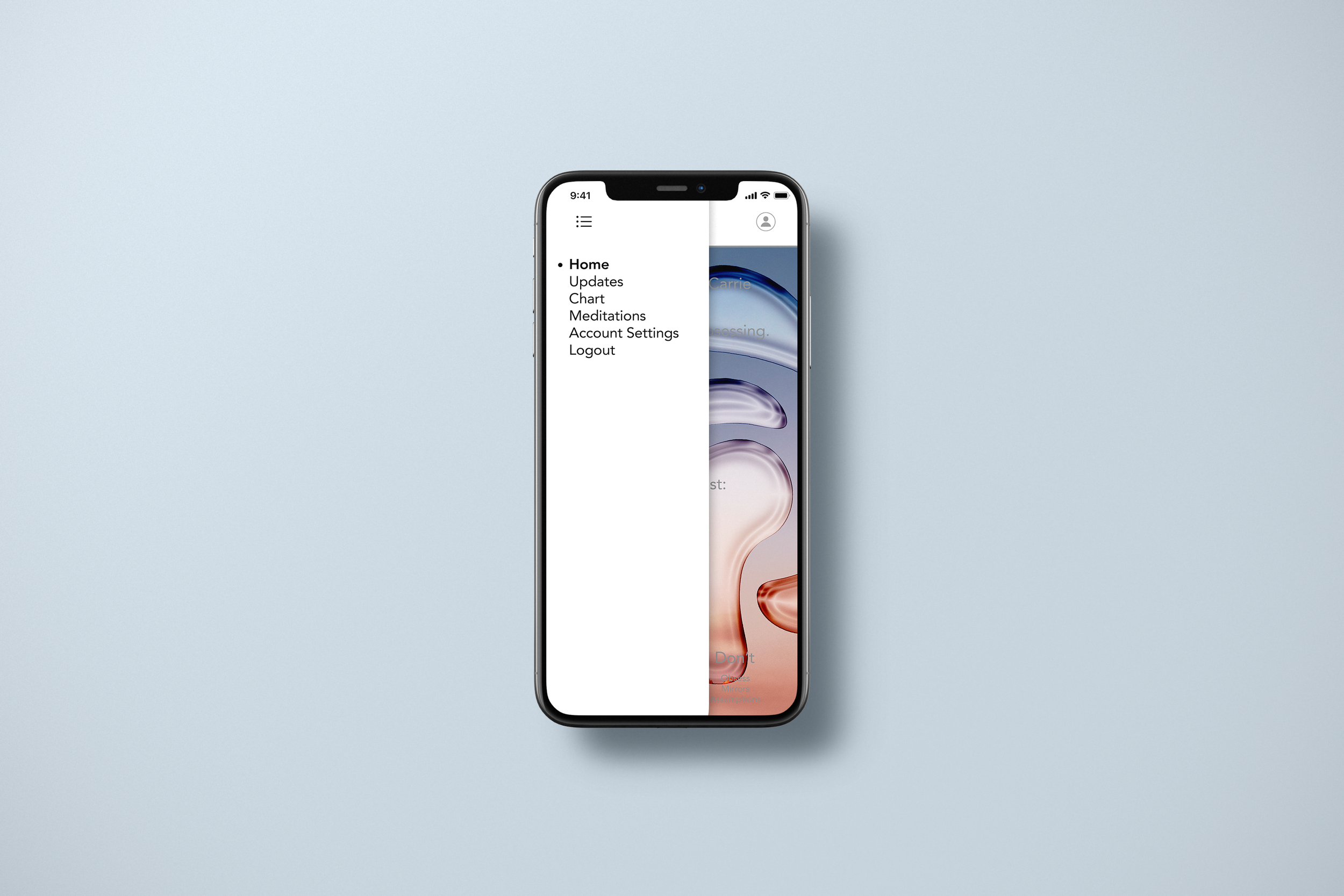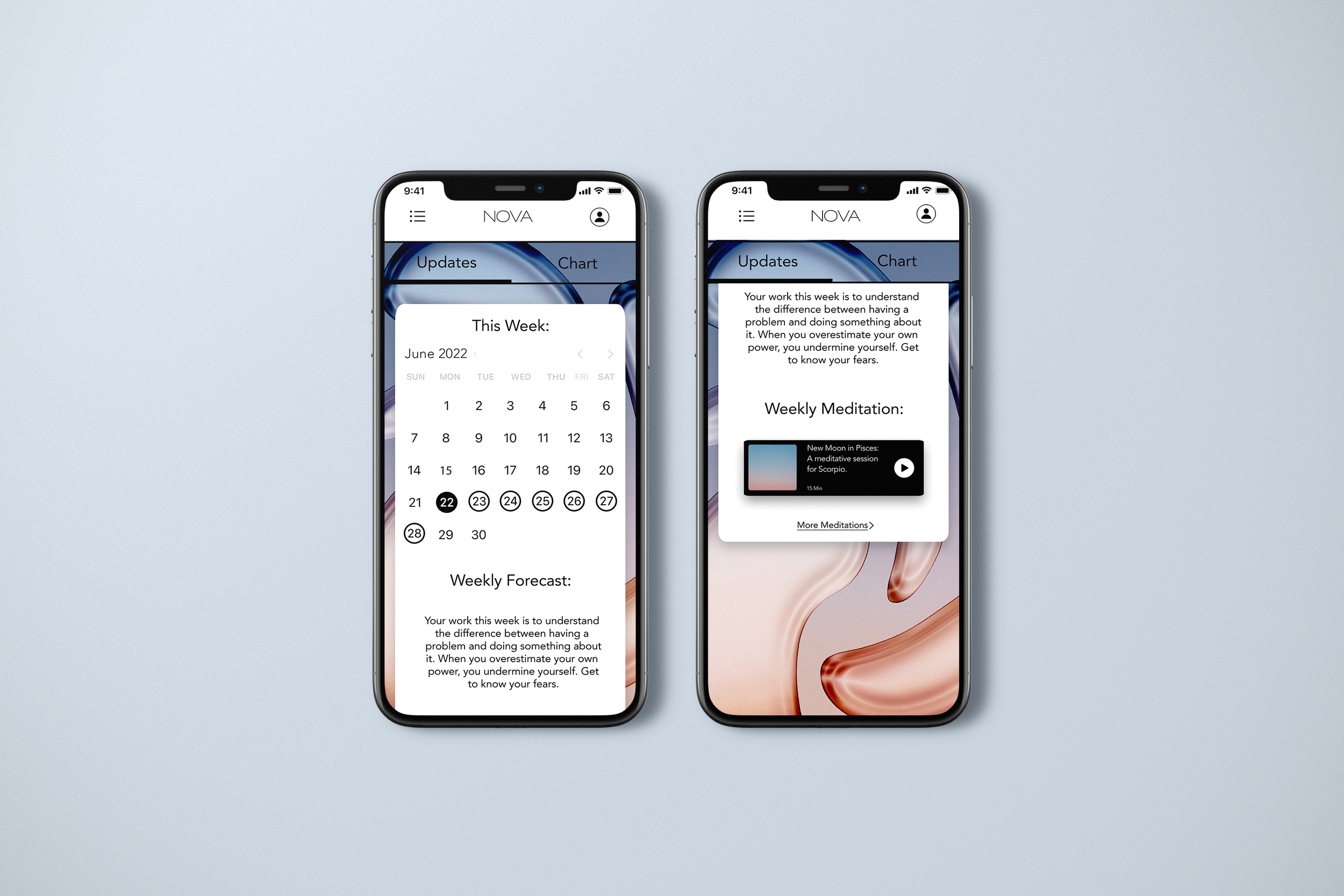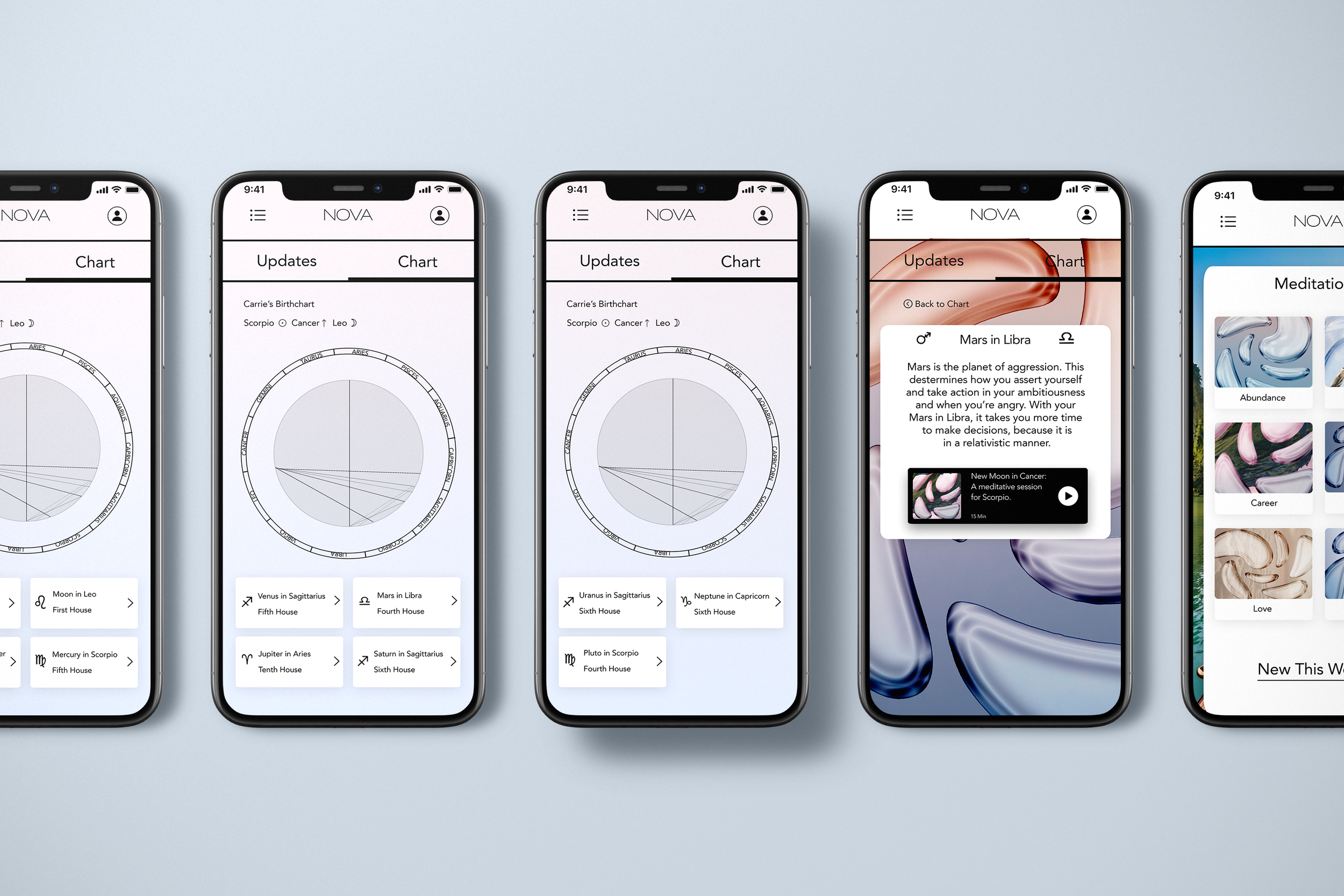
NOVA
Nova is a conceptual health and wellness app and a personalized guide to astrology. The app is designed to make astrology accessible and useful for personal growth. Nova provides a space where users can access daily horoscopes and insights to their birth chart, for the purpose of having better understanding of their true nature and move accordingly. The app also features meditations that promote a healthy lifestyle. This project presents the approach to providing users with the resources they need to connect with their spirituality.
Project Overview
CHALLENGE
Design a health and wellness app to improve the user’s experience in learning about spirituality and astrology.
ROLE
UX,UI design, visual/ graphic design, illustrator
Independently lead and apply the Design Thinking Process through the phases of development: User Research, competitive analysis, creating user flows, ideating, wireframing, content strategy, branding, prototyping, testing
TIME
4 weeks
Tools
Photoshop, Illustrator, XD
SOLUTION:
Design an application that meets the goals of the business and the user
Branding that communicates Nova’s purpose
My Process
EMPATHIZE
Research
I learned about the market for astrology and wellness through market research, user interviews, and competitive analysis.
Research Goals Include:
Identify Nova’s target market
Identify nova’s competitors and evaluate their strengths and weaknesses
Identify the current trends in mental health awareness, astrology, and spirituality
Understand everyone’s unique experience with astrology
Understand market trends of the health and wellness industry
Discover pain points that people experience outside and within the app
Market Research
Market Research consisted of understanding the consumer, demographics, general market, and trends within this industry to understand what this market entails. The goal is to understand the market for mindfulness meditation applications to further inform my design decisions moving forward. The key insights discovered consisted of:
Market Trends
The exponential growth of astrology provides opportunity for brands to capitalize, known as astrological marketing. This is done through astrology-themed products or services.
Sales of astrology-related beauty products don’t spike in comparison to services, such as apps that provide users with personalized astrological readings.
Based on the app tracking firm, Sensor Tower, it has reported that astrology apps in the US market have seen their revenues surging by 65% in 2019.
There is a surge in popularity and belief regarding space, the position of the stars and planets, and spirituality. NASA recently announced that its embarking on a new study of unidentified aerial phenomena, and directly acknowledged that something is flying in the sky that cannot yet be ascribed to known technologies or natural phenomena.
The rise of social media has caused a surge in anxiety, loneliness, and depression. This also results in a decline of community structures in millennials compared to their parents at their age.
We are in the midst of a resurgence of trends of the 1990s and early 2000s, a time when magazine horoscopes were a popular trend.
Lisa Donovan, creator of successful astrology app The Pattern, predicts a future where astrology will even be present in the workplace. Birth charts and apps will be utilized in hopes of connecting and better understanding employees.
Consumer spirituality has surged in terms of consumers engaging with market offerings such as services and products that will strengthen their spirituality.
According to the American Psychological Association, today’s youth are the most stressed age group in the 21st century. The growing adoption of unhealthy lifestyle promotes the usage of meditation apps. Millennials are turning to technology and smartphones to relax their minds, resulting in a significant boost within the market for mindful apps.
App developers are providing personal reports, reminders, and customized charts that boost the need for these apps.
The growing popularity of yoga and mystic gurus has encouraged the youth to opt for such meditation apps.
61% of Headspace’s followers are female and 38.1% are male.
Consumer Trends
Studies show that astrology has heavy validation and influence to a person’s self-concept, which reflect in their interactions with society.
Evidence shows that over 90% of adults know their zodiac sign.
According to YouGov’s latest poll, it has been recorded that one in four Americans say they believe in astrology.
According to the American Federation of Astrologers, as many as 70 million Americans read their horoscopes daily.
75% of astrology readers are women.
Younger American adults are more likely to believe in astrology than older Americans, while 37% of adults under 30 say they believe in it, less than 16% of Americans 65 and older say they do.
30% of Americans believe in astrology.
25% of downloads of the Co-Star app are young women between the ages of 18-25.
Recent Pew Research shows that younger generations are moving away from organized religion while turning to “self-directed spirituality.”
Pew Forum study also shows that a third of Americans reported a strengthening of “personal faith” following the COVID-19 pandemic. In times of crisis, people turn to astrology regularly.
Interest in astrology and spirituality is a modern form of self-analysis in which people examine all aspects of their mental health and well-being. For Gen Zs and younger Millennials, this is a form of establishing identity.
North America is the prime center for the meditation app market.
Women are meditating regularly in comparison to men.
Business Trends
According to TIME, the wellness app Co-Star raised $15 million this spring from venture capital.
According to TIME, the wellness app Sanctuary raised $3 million this spring.
The app The Pattern has a user audience of 15 million after launching in May 2017.
Revenue is made through subscriptions and paying for access to personal readings and information.
A representative from Co-Star shared with TIME that the app is downloaded every three to four seconds in the US, resulting in 20 million downloads, with no spend on marketing to date. Their growth is entirely attributed to word of mouth.
The first astrological column was published in response to the Great Depression, therefore verifying that people turn to astrology in their times of need.
As of 2032, the global mindfulness meditation apps market is slated to reach a market value of $180.34 million.
For the next decade, the compound annual growth rate of the market value for mindful meditation apps is at 8.4%.
Free mindfulness meditation apps will remain popular, accumulating 40% revenue until 2032.
Meditation apps are the most purchased health app category in the US, according to Statista.
iOS is preferred over Android in the self-care meditation app market.
The spiritual market is expected to grow a CAGR of 10% in the forecast period of 2022-2027.
Co-Star has raised over 15 million dollars in Series A funding
20 million user downloads for the Co-Star app, 25% being women ages 18-25
Competitive Analysis
Following the market research, I began to compare Nova’s competitors by evaluating their strengths and weaknesses through external research. The insights found in this process provided key information for strengths to expand upon while avoiding the weaknesses. Through my research, I compiled a list of strengths and weaknesses pertaining to the direct and indirect competitors within the industry. This includes the apps Headspace, Calm. Chani, and Co-Star.
Provisional Personas
I gathered the information gained from my secondary research to create provisional personas to gain a better understanding of Nova’s users. This assisted in determining the criteria for participants I would recruit for my user interviews and start understanding what their needs might be based on their gains and pains.
User Interviews
In order to validate these provisional personas, user interviews will be conducted with 5 participants who fit the persona criteria. I focused on asking open-ended questions about their experiences to learn as much as possible and identify what the user’s needs actually are.
I conducted interviews with 5 people, about 15-20 minutes each.
Some questions I asked during the interview:
How often do you check your horoscope?
How often to do you meditate?
What do you use to meditate?
How do sounds influence your meditation?
Where did you hear about the astrology app that you use now?
Do you find the astrological findings associated with your signs to be accurate?
How does checking your horoscope/astrology make you feel?
Does someone else’s zodiac influence your relationship/ feelings towards them?
Does astrological compatibility influence your relationships?
Tell me about your most recent experience with an astrology/ wellness application.
What makes an astrology app good to you?
After conducting the one-on-one sessions with participants, I gathered all information and synthesized it in an empathy map.
Empathy Map
I began by categorizing my notes into the categories of Doing, Seeing, Hearing, Thinking-Feeling, Gains, and Pains to gain an overall understanding of discoveries made in the interviews. I recorded the answers on sticky notes and created an empathy map to synthesize all the information within the interviews. This revealed common patterns across my research and helped me understand Nova’s users and what they need.
The patterns within the map revealed key insights which identified the user’s needs.
Word of mouth - All people shared that they find all of their wellness and astrological applications based on what other people say.
Accuracy – People expressed that accuracy in their horoscope and astrological signs are an indicator of authenticity within the app.
Finding the perfect app - When it comes to wellness and overall health, it is something that has to come from within. The market is saturated with health and wellness apps, but it is the user and their interest/awareness of their wellness journey that will determine the success of the application.
Insights
People want to resonate with the information in astrology apps.
People want uninterrupted meditations.
People care about what others think and say.
Aesthetics are important.
Needs
To read information from authentic resources.
To carry out their routine without advertisements and interruptions.
To know what other people think about new things.
To interact with something that they find visually appealing to enrich their experience.
User Persona
The main User persona was discovered through qualitative research, ethnographic field studies, primary and secondary research. I used this information to further segment our main user into a persona that accurately represents the target audience. Meet Carrie! This persona guided decisions throughout the process, as designs were centered on our user’s preferences and needs. The user has been broken down by their attributes, pain points, motivations, goals and responsibilities.
DEFINE & IDEATE
Defining the Problems
Taking the insights and needs from the empathy map, it was time to identify what problems we are solving for based on our findings about our user. To help define these problems, I gained a better understanding of Carrie’s problems by creating point-of-view (POV) statements and how-might-we (HMW) questions that would lead my brainstorming process.
POV
Carrie needs to read her daily horoscope from an authentic source that is accurate to her own personal life, because she will not entertain information that is not true.
Carrie needs to be able to engage with her meditation routine effectively without ads or interruptions, otherwise she won’t be able to meditate.
Carrie needs to know what other people say about things because she trusts others opinions.
Carrie needs to find an app that is appealing and inviting to her as a user, because it will enrich her experience with the app and inspire her to come back to the app and check her horoscope daily.
HMW
How might we provide authentic information that is in alignment with Carrie’s zodiac?
How might we provide a space where Carrie can have a successful meditation session without interruptions?
How might we help expand the reach of customers’ recommendations to reach Carrie?
How might we create an environment that positively impacts Carrie’s experience and keeps her interested?
Brainstorming
Now that we are aware of the problems that need to be solved for Marissa, I began my brainstorming process with the purpose of finding solutions to those problems. I used the HMW questions as starting points that I used to brainstorm various ideas through mind mapping.
Product Roadmap
Application Map
User Flow Sketch
Low Fidelity Wireframe Sketches
Mid Fidelity Wireframes
Style Tile
UI Kit
Final Look








Reflection & Next Steps
The NOVA app includes the functions outlined in the preliminary work and meets branding goals. Developing this astrology app was a fun project that refined my understanding of Design Thinking and the UX Research process. The secondary and primary research allowed me to empathize with the user’s experience.
I struggled with the onboarding experience, because I wanted to find a compelling way to pull information from the audience without losing their interest or demanding information. After brainstorming/research, I decided that an in-depth explanation was the best option. I did this by explaining why birth date, time, and location are relevant in astrology. This made the onboarding experience engaging and personal for the audience, resulting in the personalization that users look for in astrology apps.
Future improvements that I can make in the design process include further usability testing that addresses navigation and accessibility. With new revisions and branding incorporated, re-testing is an important step in the process that ensures the design’s overall usability. Another improvement in the app includes a social aspect where users can connect with each other.




































